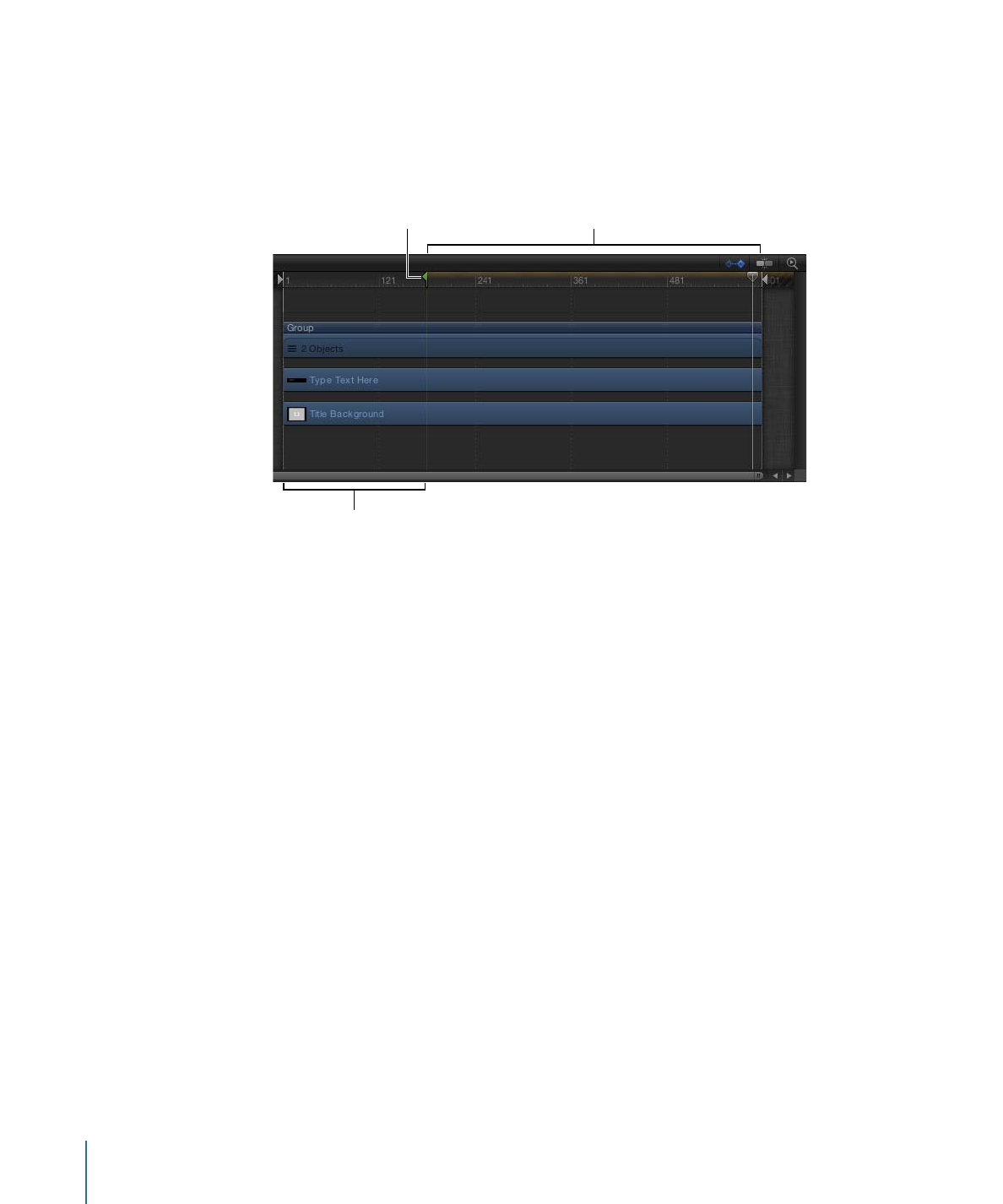
Working with Markers in Templates
Markers are visual reference points you add to the Timeline to identify specific frames.
There are seven types of markers. The first type, known as Standard, is designed for use
in Motion and has no effect if saved in a Final Cut template. The Standard marker type
can be added to an object (an object marker) or to the overall project (a project marker).
The remaining marker types, known as template markers, are designed to control the
timing of templates in Final Cut Pro X. To apply a template marker, you must first apply
a standard project marker, then change the marker type in the Edit Marker dialog.
For more information on using working with markers in the Timeline, see
Adding Markers
.
When building a template, you typically don’t know the duration of the clips it will be
applied to in Final Cut Pro. Template markers let you control the timing of a template
after it is applied in Final Cut Pro by designating regions in the Timeline to be played,
ignored, or looped to match the duration of the target clip. You can also designate a
specific frame to be used as the template’s thumbnail in the Final Cut Pro Effects,
Transitions, or Titles Browser.
Template markers fall into four categories: Build In, Build Out, Loop, and Poster Frame. Build
In markers instruct Final Cut Pro to play an intro animation in specific instances. Build Out
markers instruct Final Cut Pro to play an outro animation in specific instances. Loop
markers indicate where the template should begin looping playback. Poster Frame markers
determine the frame of a template to be used as the thumbnail for the template in the
Final Cut Pro Effects, Transitions, or Titles Browser.
Build In markers designate the end point of an intro section of a template, and instruct
Final Cut Pro to play that section at the same speed as the original template (as created
in Motion), regardless of the duration of the clip in the Final Cut Pro Timeline. Build Out
markers designate the start of an outro section of a template, and instruct Final Cut Pro
to play that section at the same speed as the original template (as created in Motion),
regardless of the duration of the clip in the Final Cut Pro Timeline.
You can also specify a build-in or build-out section as optional. When you add the optional
Build In or Build Out marker, a corresponding checkbox is added to the Publishing pane
of the Project Inspector in Motion. When you apply a template to a project, the checkbox
also appears in the Final Cut Pro Inspector. Deselect the checkbox to disable the build-in
or build-out portion of the effect.
When you add Build In, Build Out, or Loop template markers to a Motion project, the
Timeline ruler displays a gold glow over the affected region.
552
Chapter 11
Creating Templates for Final Cut Pro X

If no Build In or Build Out markers are present, the entire template is time-stretched to
correspond to the duration of the clip when applied in Final Cut Pro. If Build In or Build
Out markers are present, only the portion of the Motion project between the
marker-defined intro or outro section is time-stretched; the marker-defined region retains
its original timing. When creating templates, use template markers to control which
portions of the effect, title, transition, or generator are time-stretched and which portion
are left alone.
Note: Transition templates assume a default duration in Final Cut Pro (determined in
Final Cut Pro Preferences). This duration can conflict with the effects of these marker
types. For example, you might specify that the intro animation of a transition lasts for
45 frames, while the default duration in Final Cut Pro is set to 30 frames for the entire
transition. To override the Final Cut Pro default duration, select the Override FCP Duration
checkbox in the Project Properties Inspector of Motion. For more information, see
Creating
a Transition for Final Cut Pro X
.
The marker types include:
• Standard: The default marker for use in Motion. This marker has no effect on templates
in Final Cut Pro.
• Build In – Mandatory: Indicates the last frame of an intro section. Frames between the
beginning of the project and the Build In – Mandatory marker play for the duration
specified in the Motion project.
This intro is always played, regardless of where the template is placed in the Final Cut Pro
Timeline.
• Build In – Optional: Sets the last frame of an intro section. When a Build-In Optional
marker is added to a template, a Build In checkbox is published (added to the Published
Parameters list in the Publishing pane of the Project Inspector). After the template is
added to a Final Cut Project, the Build In checkbox appears in the Inspector.
553
Chapter 11
Creating Templates for Final Cut Pro X

When the Build In checkbox is selected in the Final Cut Pro Inspector, frames between
the beginning of the project and the Build In – Optional marker play at the duration
specified in the Motion project. When the checkbox is deselected, frames before the
marker are not played.
This section is played
regardless of the state of
the Build In checkbox.
Build In – Optional
marker
The intro section is played only when the Build In
checkbox is selected in the Final Cut Pro Inspector.
• Build Out – Mandatory: Sets the first frame of an outro section. Frames between the
Build Out – Mandatory marker and the end of the project play for the duration specified
in the Motion project.
This outro is always played, regardless of where the template is placed in the
Final Cut Pro Timeline.
• Build Out – Optional: Sets the first frame of an outro section. When a Build Out – Optional
marker is added to a template, a Build Out checkbox is published (added to the
Published Parameters list in the Publishing pane of the Project Inspector). After the
template is added to a Final Cut Project, the Build In checkbox appears in the Inspector.
554
Chapter 11
Creating Templates for Final Cut Pro X

When the Build Out checkbox is selected in the Final Cut Pro Inspector, frames between
the Build Out – Optional marker and the end of the project play at the duration specified
in the Motion project. When the checkbox is deselected, frames before the marker are
time-stretched and frames after the marker are not played.
The outro section is played only when
the Build Out checkbox is selected in
the Final Cut Pro Inspector.
Build Out – Optional
marker
When the Build Out
checkbox is deselected in the
Final Cut Pro Inspector, this
section is time stretched.
• Project Loop End: Sets the last frame of the section to be included when the template
is used in Final Cut Pro. When playback reaches this frame, the project plays from the
beginning of the project or from the Build In marker, if present. Frames beyond the
Project Loop End marker are never played.
Project Loop End marker
Frames in this section
are looped.
555
Chapter 11
Creating Templates for Final Cut Pro X

Setting a marker type to Project Loop End changes any marker set to a Build Out type
back to Standard. Similarly, if a Project Loop End marker exists, adding an Outro marker
resets the loop marker back to Standard.
Tip: Adding a loop marker to the second frame in a template signals that the effect is
time-invariant—the first frame of the project loops forever. This can be useful for
generators that do not contain animation, such as a solid color generator, or for filters
that are not animated by default, such as a color correction filter.
Note: Templates with applied Time filters (Echo, Scrub, Strobe, Trails, or WideTime)
should not use Loop markers, because unexpected timing results can occur.
• Poster Frame: Sets the frame to be used as the template’s thumbnail in the Final Cut Pro
Effects, Transitions, or Titles Browser.